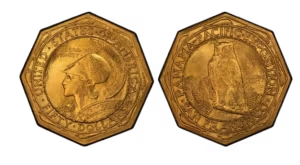1915-S Panama Pacific Coins Celebrate One of the Greatest Engineering Feats in History
Posted on — Leave a commentThe opening of the Panama Canal in 1914 represented one of the greatest engineering feats in the history of the world at that time. Throughout the 1800s, businessmen around the globe wanted to ship goods quickly and cheaply between the Atlantic and Pacific coasts—and the long-awaited opening of the Panama Canal transformed global trade.
businessmen around the globe wanted to ship goods quickly and cheaply between the Atlantic and Pacific coasts—and the long-awaited opening of the Panama Canal transformed global trade.
It had been a long time coming. In 1881, the French tried, and failed, to build a pathway to connect the Atlantic and Pacific oceans. When the United States took it over in 1904 and took the project to completion in 1914, it cemented the technological prowess and growing influence of America on the world stage.
In January 1915, Congress authorized the production of five commemorative coins for the Panama-Pacific International Exposition, to be held that year in San Francisco. The legislation authorized a silver half dollar, a gold dollar, a gold $2.50, and two $50 gold pieces (one round and one octagonal). The octagonal version was the first and only time that the U.S. Mint produced a non-round coin.
The U.S. Mint, however, faced challenges during the production of the 1915-S Panama-Pacific coins. First, there was the tight timeline. The authorizing legislation for the coins was passed in early January 1915, yet the Panama-Pacific International Exposition opened on February 20, 1915!
The law required coins to be ready by the exposition’s opening, which proved impractical due to the short time frame between the law’s passage and the fair’s start. The Mint tried to act quickly, but coins were not available for sale at the opening of the exposition.
Then there was also the mint mark controversy. A major production hiccup emerged when the first dies for the gold dollar and half dollar arrived at the San Francisco Mint without the customary “S” mint mark!
The Philadelphia Mint Superintendent had thought the mint mark was unnecessary since all coins were being struck in San Francisco, but Mint Director Robert W. Woolley disagreed, fearing confusion with Philadelphia issues and local backlash. As a result, all dies had to be returned to Philadelphia for reworking to include the mint mark, which caused even more delays.
Today, the 1915-S Panama–Pacific commemorative coins are among the most storied and sought-after issues in American numismatics, in part due to the remarkable achievements they commemorate.
Between February and December 1915, over 18 million people from around the world visited the Panama-Pacific International Exposition, which sat on over 600 acres in San Francisco’s Marina District.
The Exposition celebrated the completion of the Panama Canal, and also showcased San Francisco’s remarkable recovery from the devastating 1906 earthquake and fire. The World Fair also promoted technological and motor advancements, including a demonstration of a transcontinental telephone call, and events to promote the use of automobiles.
Minted to celebrate a pivotal moment in U.S. history, these coins embody both artistic achievement and historical significance. Charles Keck designed the 1915-S Panama-Pacific $1 gold coin. The obverse features the head of a man representing a Columbian laborer. On the reverse, two dolphins encircle ONE DOLLAR.
Charles E. Barber designed the 50c silver commemorative, which showcases Lady Liberty scattering flowers on the obverse and an eagle perched on a Union shield on the reverse.
The 1915-S Panama-Pacific commemorative coins are enduring symbols of American engineering prowess and resilience. Their origins in a world’s fair celebrating the Panama Canal and San Francisco’s rebirth, combined with their low mintage, artistic beauty, and deep historical significance, cemented their place among the most treasured U.S. commemoratives.
Want to read more? Subscribe to the Blanchard Newsletter and get our tales from the vault, our favorite stories from around the world and the latest tangible assets news delivered to your inbox weekly.








